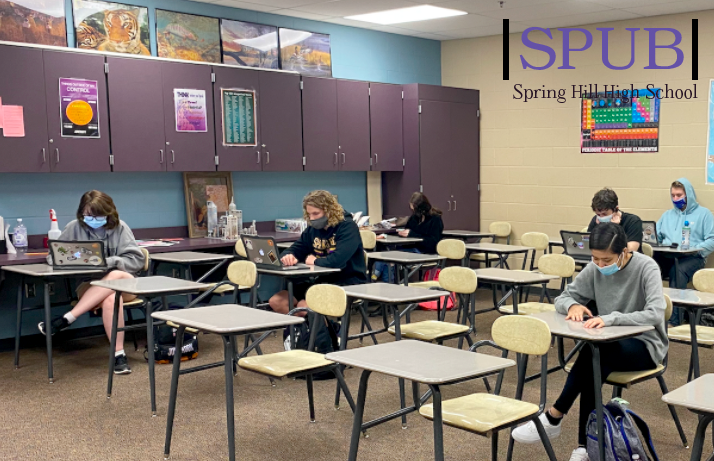Teachers Analyze Benefits, Drawbacks of Online School System
If there is one thing the pandemic has brought to light, it’s that there is no one way to teach students, and none of the ways are simple and easy. If there was ever an example of that it is Edgenuity.
“Edgenuity is an online curriculum that [the school district] has purchased to use for credit recovery…it primarily provides curriculum for core classes for all grade levels with a few electives thrown in,” said Tim Shea, the administrative overseer for the school’s use of Edgenuity and Assistant Principal.
It’s an online program that allows students to move through videos, assignments, and quizzes to learn content that would be taught at the school and in the classroom, but was created by a separate company. Throughout this year, particularly, it has served several different purposes.
“The [optional remote learning] students were provided an opportunity to use Edgenuity for elective credit, so you will see a lot of intro to art, a lot of health medicine [and] terminology, stuff like that. Students in the building taking Edgenuity are those students who need to recover credits for classes, primarily core classes, in which they failed to earn credit in the classroom,” explained Shea.
Almost no one feels that it does a better job than real teachers in the classroom.
“There is so much to be said about learning electives in person because the teacher can make each semester different and specific to the students in person and you get those discussions,” said Karla DeCoster, Edgenuity curriculum manager and math teacher.
It just doesn’t allow for the same level of learning.
“I’ll be honest, [Edgenuity] is not as good [as the classroom]. Kids learn better in the classroom. A student can’t build a relationship with a computer, he builds relationships with the teachers. Teachers can understand the nuances in how a kid learns, where they are missing and fill in that gap…teachers help students master the content, computers help students manage the content area and that’s a significant difference,” explains Shea.
However, Edgenuity does serve a significant purpose inside the school.
“It saves resources – I can put one teacher in a room with 20 kids and they can facilitate the students as they move through. It [also] gives kids a second chance using what they have learned in the classroom to pick up from there and not jeopardize their academic standing and graduation plans,” said Shea.
This is what Brett Gearhart, credit recovery teacher, views as the major benefit of Edgenuity.
“The biggest benefit is that it allows kids to catch up on credits. I think there is a big gap of maturity that happens between freshman and senior year. Freshman year we have typically an influx of Fs because first semester we don’t necessarily take things seriously. We are socializing…and we aren’t really paying attention much in class and then we realize our sophomore or junior year ‘oh man I messed up really bad my freshman year and now I might not be able to graduate.’ Well this allows them to make up for that mistake and not let that mistake define who they are, moving forward in the future,” said Gearhart.
However, Shea fears that sometimes students take advantage of this system – this is why the school only rewards pass/fail credit for credit recovery.
“Some kids see Edgenuity as a shortcut to getting a grade. So they will fail classes intentionally just to take an online class where they presume they can simply punch buttons and then move on,” said Shea.
He compared it to a baseball game and giving a player more than three strikes.
“I always wonder how many kids would actually accept an F if they didn’t have the option of being able to take [Credit Recovery] in their schedule next semester to make it up….How many kids will take three strikes before they swing?” asked Shea.
Instead Shea wishes that students would see it as a “one time assistance,” to get them through a difficult area.
“Hopefully, I don’t have a kid who is going to be in Edgenuity for eight classes, that he will only be in there for one class and then that’s the last we’ll see of him. Unfortunately, it’s been my experience here that we have some kids that graduate with 11 credits done via Edgenuity…which is ridiculous. Some school districts will not allow a student to graduate with more than two or three done through this. We don’t have an alternative school to send these kids to, so Edgenuity becomes our vacuum cleaner to clean up these kids and get them moving in the right direction,” said Shea.
This is the other way that Edgenuity could be used – as a curriculum for an alternative school. An idea that Shea points out is still “just conjecture.” An alternative school would be another place to send non-traditional students to allow them to graduate.
“[Alternative education is] an education that was like ‘hey let’s get you in make sure you know what you need to know and then we will let you go to the world because that’s where you want to be,’” explained Gearhart.
Edgenutiy serves and can serve many purposes, however, at the end of the day it will never replace real interactions with real teachers. It does, however, allow for mistakes to happen and to give students a place to fix and learn from those mistakes, which at the end of the day is what high school is really about.

Hi readers. I'm Hannah Smith. I'm StampedeNews.Net's new Copy Editor which means if you weren't already tired of seeing me around here then buckle up because...


